5th / 6th December - Feast of St. Nicholas and Krampus
Written by Anne Newman 6th December 2018 up-dated 2022 & 2023
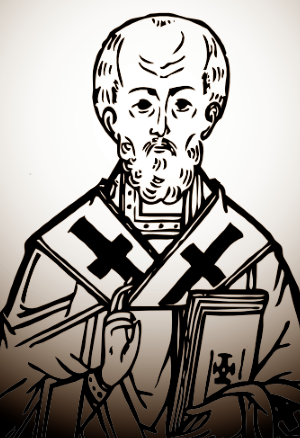
Saint Nicholas
6th December is the feast day of Saint Nicholas, the patron saint of children, and also patron of sailors and prisoners. St. Nicholas is a major saint in many European and Eastern countries.
It is an old tradition that children leave their shoes out overnight in front of the fireplace, on the window sill, or outside their bedroom door so that St. Nicholas can fill them with sweets and small gifts and treats.
St. Nicholas’ feast day traditions vary widely from country to country, but they all carry the same theme of small gifts and treats left in either shoes or stockings.
He lived in the fourth century. This famous saint was born in Asia Minor, which is modern-day Turkey. After his parents died, he gave all his money to charity.
Once a certain poor man was about to abandon his daughters to a life of sin because they did not have the money for a dowry. Nicholas heard about his problem. He went to the man's house at night and tossed a little pouch of gold through a window. This was for the oldest daughter. He did the same thing for the second daughter.
The grateful father kept watch to find out who was being so good to them.
When St. Nicholas came a third time, the man recognized him. He thanked Nicholas over and over again.
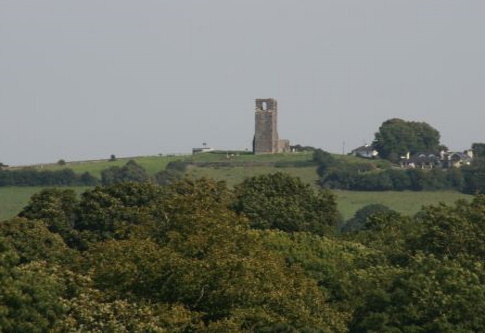
According to local Irish legend, Saint Nicholas was buried in the 12th Century in the ruined Church of St Nicholas, Jerpoint. Co. Kilkenny. The church is all that remains of the medieval village, Newtown Jerpoint, that fell to ruin by the 17th century.
He is also the patron saint of Galway City. It is thought that sailors and merchants, from their travels, brought devotion to him to Galway.
He is also connected to Skryne / Skreen, Meath, visible from Hill of Tara. A chapel attached to the castle was dedicated to him.
The children hang up their stockings near the chimney so that Santa Claus will put something in them. They think that he comes in a slegde filled with socks of toys and that he comes down the chimney. They write notes to him telling him what kind of toys they want. They throw the notes up the chimney. They think that he spends the year making toys. They also think that he lives in the north and that he has a beard to keep him warm. School's collection - Santa visits
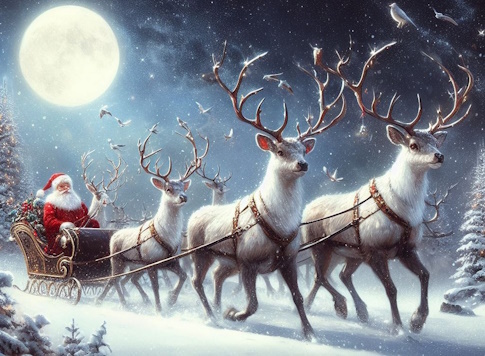
St Nicholas to Santa Claus
After the Reformation in the 16th century Saint Nicholas became unpopular. He regained standing in the early 1800s. In the intervening years many countries grew a tradition of a person who judged children's behaviour and brought presents for the good ones and unpleasant gifts to the naughty ones.
In the Netherlands children leave clogs or shoes out (rather than a stocking) on the 5th December (St. Nicholas Eve) to be filled with presents. They also believe that if they leave some hay and carrots in their shoes for Sinterklaas's horse, they will be left some sweets.
We now have the story that Santa lives at the North Pole. In Finland, they
say he lives in Lapland.
The poem The night before Christmas - aka A visit from St Nicholas - by Clement Clarke Moore helped to popularise the ideas of the kindly old man visiting children....
| "He was chubby and plump, a right jolly old elf" - | 'Twas the night before Christmas, when all through the house Not a creature was stirring, not even a mouse; The stockings were hung by the chimney with care, In hopes that St. Nicholas soon would be there ...... |
and gave us the names of the reindeer - Dasher, Dancer, Prancer, Vixen, Comet, Cupid, Donner (who's also been called Dunder and Donder), Blitzen (who's also been called Blixem, Blixen and Blicksem)
Krampus
On the evening of 5th December, Krampus Night or Krampusnacht, the wicked hairy devil Krampus appears on the streets in many parts of Germany, Austria and Bavaria.
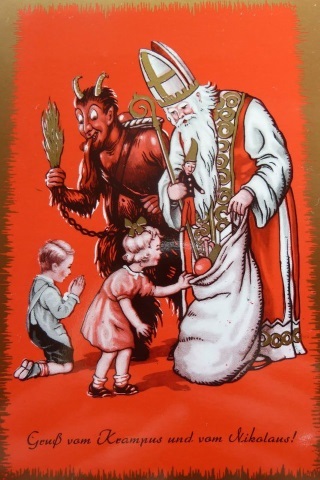
Sometimes accompanying St. Nicholas and sometimes on his own, Krampus visits homes and roams the streets.
St Nicholas concerns himself only with the good children, bringing gifts and sweets.
Krampus is concerned with the bad children, bringing them coal and a bundle of sticks.
Krampus' roots may date back to pre-Germanic paganism in the region.
His name comes from the German krampen, which means "claw," and tradition has it that he is the son of the Norse god of the underworld, Hel.
I remember being told that Santa brought coal and sticks to bold children so I wonder if there was a folk memory here of Krampus’ deeds. But I never heard of Krampus until about ten years ago when Tom ‘discovered’ him while researching Yule and Christmas and other winter celebrations when he was MC for one of the Tara Celebration's Yule Celebrations.
On Krampusnacht processions Krampus and Saint Nick come to life through the use of costumes and wooden masks.
The Krampus is the yin to St. Nick's yang. Like all seasonal masked celebrations it seems to acknowledge the good and evil in us all. Being masked gives people an opportunity for ‘devilment’ and to explore and acknowledge ‘the darkside’ of our personalities.
While Krampus may be king of holiday scares, his fans may be overlooking an equally nasty, much more formidable queen — a Christmas monster who lives further north, in Iceland who goes by the name Grýla, the Christmas witch.
Whitby Krampus Run is the UK's first Krampus run and it is always held on the weekend closest to the Eve of St Nicholas Day.
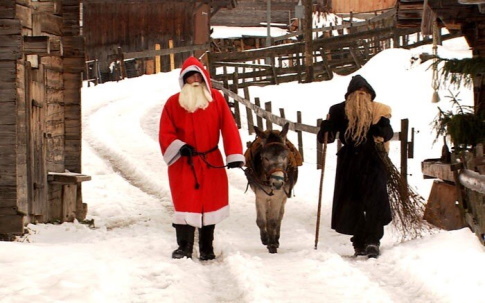
Schmutzli
In Switzerland, a dark character is an integral part of their Christmas celebration.
Dressed in a brown robe and wearing a blackened face, Schmutzli (from Schmutz or “dirt”) is a sinister sidekick to the gift-bearing Samichlaus (Santa Claus or St. Nicholas).
Known as Schmutzli in the German part of the country and Père Fouettard (from "whip") in French, Samichlaus's alter ego usually carries a broom of twigs for administering punishment to children whose behaviour throughout the year has not been up to scratch.
Kurt Lussi, the curator of religious folklore at Lucerne's History Museum, says that the St Nicholas custom in Switzerland became interwoven with a festival of noise and masks dating back to pre-Christian times.
Schmutzli, he says, was a symbol of the evil spirits which these ancient festivals sought to drive out with a combination of noise and light. Winter processions involving loud noise and lanterns continue to this day in many parts of Switzerland.
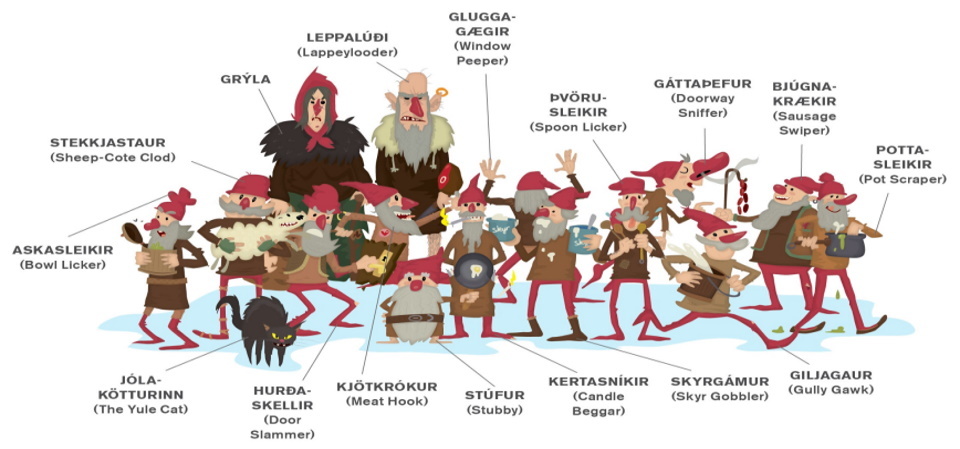
13 Yule Lads!
One Santa Claus is not enough for Icelanders. We have 13 Yule Lads!
For the 13 nights before Christmas Eve, one of the troublesome brothers visits Icelandic homes to tease residents.
This morning Icelandic children awoke to see the gift left behind by the first visiting Yule Lad (good children get a small gift left in their shoe, naughty children get a potato!).
Meet the 13 pranksters with names such as “Door Slammer”, “Bowl Licker”, and the rest of the family: 13 Yule Lads list
Souce - Icelandair.





